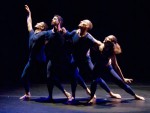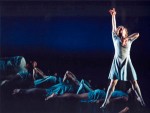Title
Along with Ohad Naharin’s new work, three venerable, major modern dance choreographers are represented on the Juilliard Dances Repertory program. Twyla Tharp’s The Fugue (1970) and Mark Morris’s Gloria (1981) are among the earliest works by those influential choreographers to remain in active repertory. Lar Lubovitch’s North Star (1978), which the senior class will reprise after performing it this past fall (as part of Lubovitch’s 40th-anniversary events) at both Dance Theater Workshop and City Center, is from a period when he hit his stride and discovered a particular affinity for the then-emerging minimalist composers.
Left to right: Fourth-year dancers Leon Kupferschmid, Michaeljon Slinger, Nathan Madden, and Rachelle Rafailedes in a performance of Lubovitch's North Star at Dance Theater Workshop in October.
(Photo by Nan Melville)Left to right: Meghan MacAlpine, Allison Manning, and Christina Ilisije in Twyla Tharp's The Fugue at Marymount Manhattan College's 2007 Spring Repertoire series.
(Photo by Rosalie O'Connor)Lauren Grant (upright) and other members of the Mark Morris Dance Group in Morris's Gloria, from the company's 25th anniversary season in 2006 at BAM.
(Photo by Mark Morris Dance Group / Stephanie Berger)Body
The Fugue is an endlessly fascinating, rigorous work for three dancers, performed without musical accompaniment. Tharp emerged as a bold innovative force in dance in the 1970s, and The Fugue—in which she originally performed with Sara Rudner and Rose Marie Wright—launched that decade auspiciously. She composed 20 variations on a 20-count theme, masterfully and intricately mining the material to create a work that is challenging for both performers and audience. In her autobiography, Tharp placed this seminal work in context: “I dismissed everything up to this point—our first five years of work—as lessons. Now I used the contrapuntal techniques I had gained from our early work to put my craft at the service of creating and resolving tension.” Initially it was always danced by women (no one who saw the original trio, chic and severe in their boots, can forget their riveting impact), but Tharp later offered an all-male cast as well. (An all-male cast will alternate with an all-female cast at Juilliard.) Tom Rawe and Jennifer Way, members of Tharp’s company during the 1970s and ’80s, are staging the work for Juilliard.
Mark Morris’s affinity for Baroque vocal music—which has become a rich, significant focus within his varied repertory—was already much in evidence when he created Gloria, which is set to Vivaldi’s Gloria in D Major and will be staged at Juilliard by Megan Williams, a former Mark Morris company member. The movement for the 10 dancers has a beautifully natural and unforced connection to the music. Morris captures the score’s melancholy and exhilaration, filling the stage with movement that is both rooted and soaring. At this early stage of his career, he evidenced a touching acknowledgement of the principles of early American modern dance, while already displaying his own distinctive sensibility.
In Lubovitch’s North Star, the nine dancers’ bodies seem to breathe as one, forming constellations that are buoyed along by Philip Glass’s vibrant, pulsating score. The choreography revels in a lush fluidity, although a stark female solo—in which the woman’s body seems to shake and oscillate with dire omniscience—interrupts the seemingly carefree, endlessly curving action of the other sections.







